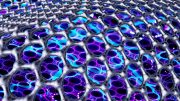
Understanding supervolcanoes is key to preparing for the rare but inevitable super-eruptions, occurring roughly every 17,000 years.
Curtin scientists are part of an international research team that studied an ancient supervolcano in Indonesia and found such volcanoes remain active and hazardous for thousands of years after a super-eruption, prompting the need for a rethink of how these potentially catastrophic events are predicted.
Associate Professor Martin Danišík, lead Australian author from the John de Laeter Centre based at Curtin University, said supervolcanoes often erupted several times with intervals of tens of thousands of years between the big eruptions but it was not known what happened during the dormant periods.
“Gaining an understanding of those lengthy dormant periods will determine what we look for in young active supervolcanoes to help us predict future eruptions,” Associate Professor Danišík said.
“Super-eruptions are among the most catastrophic events in Earth’s history, venting tremendous amounts of magma almost instantaneously. They can impact global climate to the point of tipping the Earth into a ‘volcanic winter’, which is an abnormally cold period that may result in widespread famine and population disruption.
“Learning how supervolcanoes work is important for understanding the future threat of an inevitable super-eruption, which happens about once every 17,000 years.”
Associate Professor Danišík said the team investigated the fate of magma left behind after the Toba super-eruption 75,000 years ago, using the minerals feldspar and zircon, which contain independent records of time based on the accumulation of gasses argon and helium as time capsules in the volcanic rocks.
“Using these geochronological data, statistical inference and thermal modeling, we showed that magma continued to ooze out within the caldera, or deep depression created by the eruption of magma, for 5000 to 13,000 years after the super-eruption, and then the carapace of solidified left-over magma was pushed upward like a giant turtle shell,” Associate Professor Danišík said.
“The findings challenged existing knowledge and studying of eruptions, which normally involves looking for liquid magma under a volcano to assess future hazard. We must now consider that eruptions can occur even if no liquid magma is found underneath a volcano – the concept of what is ‘eruptible’ needs to be re-evaluated.
“While a super-eruption can be regionally and globally impactful and recovery may take decades or even centuries, our results show the hazard is not over with the super-eruption and the threat of further hazards exists for many thousands of years after.
“Learning when and how eruptible magma accumulates, and in what state the magma is in before and after such eruptions, is critical for understanding supervolcanoes.”
The study was led by researchers from Oregon State University, and co-authored by researchers from Heidelberg University, the Geological Agency of Indonesia, and by Dr Jack Gillespie from Curtin’s School of Earth and Planetary Sciences and The Institute for Geoscience Research (TIGeR), Curtin’s flagship earth sciences research institute.
Reference: “Resurgence initiation and subsolidus eruption of cold carapace of warm magma at Toba Caldera, Sumatra” by Adonara E. Mucek, Martin Danišík, Shanaka L. de Silva, Daniel P. Miggins, Axel K. Schmitt, Indyo Pratomo, Anthony Koppers and Jack Gillespie, 3 September 2021, Earth and Environmental Sciences.
DOI: 10.1038/s43247-021-00260-1









Has anyone noticed that these supervolcano eruptions seem to occur during the Grand Solar Minimals? Our last volcanic Winter came concurrently with the Mauder Minimal(the little ice age). Likewise: the previous mass eruptions seem to also concur uncomfortably with past GSM’S.
While our sun cycles are based on eleven-year cycles. The minimal is not on the typical eleven-year solar cycles but instead are on about three hundred and fifty years to four hundred. If as Solar physicist Valentina Zharkova has pointed out we are not now in just a typical GSM but instead a Super GSM. My understanding is the diminished solar activity reduces the muons which are responsible for locking the magnetic fields together, Once diminished the fields then weaken. This may be enough to unleash the eruptions. A Super Grand Solar Minimal may be enough to set them all off at about at once, The Super Volcanos could go off simultaneously much like pop caps at a beer party. It could get very cold very rapidly.
“Our last volcanic Winter came concurrently with the Mauder Minimal(the little ice age).”
This is an unconventional spelling and name for what is more commonly called the Maunder Minimum. To the best of my knowledge there was no abnormal volcanic activity during the Maunder Minimum. This reads like some Velikovsky-like speculations that are not supported by mainstream physics. I suggest that you do some background reading before posting wild ideas.
https://www.britannica.com/science/muon
Its cool to see an intelligent theory presented, though my knowledge of how muons contributes to this, It would be exciting to hear a response from someone else upon the matter. Ill do some research my self about this now. But it sounds plausible at first glance.
What is intelligent about it? Using unfamiliar words (and improperly) to develop an unsupported conjecture is the opposite of “intelligent.”
https://www.energy.gov/science/doe-explainsmuons
How can something that does not react with rock, and only survives 2.2 microseconds, be responsible for volcanic eruptions?
This is a half baked comment. ‘Locking fields together’
Perhaps in a Hollywood script, but this has no basis in reality.
Didn’t we see something like this in Ghost Busters when they “crossed beams?” 🙂
Ankle-biting comes easy to the pathetic and feeble-minded. Unless you can come up with a better idea, feel free to S.T.F.U.
If someone claims that the “moon is made of green cheese,” I have no responsibility to offer an alternative explanation. It is sufficient to point out the impossibility while simultaneously biting their ankle. Further demonstration that you don’t understand how science works.
I asked, “How can something that does not react with rock, and only survives 2.2 microseconds, be responsible for volcanic eruptions?” You didn’t even bother to try to explain, you instead, said that someone who would ask such a question must be “pathetic and feeble-minded.” You aren’t doing anything to increase your credibility.
Unfortunately, there is no edit feature. The above was un-edited. I am certain it appears half-baked. The evaluation of the theory was also in error on several points in the premises as was the (not-valid) conclusion. It should also be noted that very many of these eruptions also occurred during the Solar Maximals, such as the Lombok Indonesia eruption. Most of my studies were with the GSM/M cycles. I am just noting the proximity of the eruptions to the solar timeline. Yes, I have read a great much about the subject. Let’s just hope these are the rantings of a crackpot. A crackpot is not so bad. It places me amongst very distinguished company. Meanwhile, I will be adding an extra layer of insulation in my attic. My concluding point is that these eruptions are possibly triggered by the minimal/maximal solar cycles. Super-volcanoes are one explanation to answer for the climatic cool-off cycles. as well. Many of which lasted for hundreds of years. The skeptics must take a number and get in line.
https://lweb.cfa.harvard.edu/~wsoon/myownPapers-d/Summer_of_1816.pdf
Interesting link. Thanks. However, a weak solar maximum is not quite the same thing as an extended Grand Solar Minimum.
That’s easy to answer, Clyde. In the same way that Trumpers take horse dewormer and iodine as a form of hillbilly Cocid-19 vaccine, so do they also create other QAnon-like narratives that sound like science to the uneducated, the ignorant, and those who want to believe a lie.
just to clarify my little understandings of this matter and to add to the discussion,are muons like the dispersing and trickling down of radiation from outside our atmosphere(cosmic/intergalatic rays) being this is true then is it posible that GSM could increase the percentages of muon generation and intensity upon earth, thus could that inturn then be a cause of change in the viscosity of magma within they’re chambers within the earth causing potential for a Volcanic winter? I know there is alot of conjecture in this comment,i’m just putting it out there because i can see alot of the posts here have some learned people behind them, cheers for the substance of the discussion minus hostility, Peace.